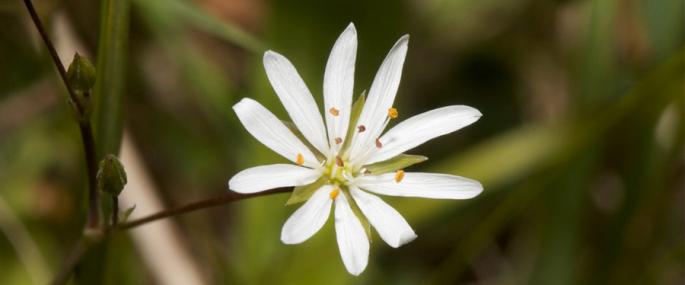Lesser Stitchwort
A perennial wildflower that forms low clumps amongst grasses and bears many small white flowers.
Wildflower meadows are one of the country’s fastest disappearing habitats; about 95% of wildflower meadows have been lost due to agricultural intensification. Wildflower meadows should be maintained by mowing when the seeds have set - remove the cut material to help lower soil fertility so that the wildflowers can thrive without competition from coarse grasses. Summer flowering plants should be mown in spring and then left to flower for the rest of Autumn.
By volunteering with your local Wildlife Trust you'may be able to get directly involved in managing your local wildflower meadows.

Arthur's Meadow
A beautiful flower-rich meadow passed by many who zip along on the A14 but noticed by few. The meadow is bordered by old and new hedgerows and the meadow itself has been totally unimproved by ploughs or fertilisers for hundreds of years.
Yellow Star-of-Bethlehem
This golden yellow star-like flower is found growing in woodland on basic soils. Though rare, it can be very abundant where it does occur.
Keep an eye out in early spring for the striking yellow flowers. They can be lost amongst the lesser cellandine and, as a result, this plant is under recorded. If you are lucky enough to find a plant please report it to your local Biological Records Centre and Wildlife Trust.

Letcombe Valley
Community nature reserve

Green-winged Orchid
This short orchid is a plant of unimproved drier grassland, usually flowering in May or June.
The UK has lost over 97% of its unimproved hay meadows. The Wildlife Trusts own and manage many such reserves and promote sympathetic management with private landowners and organisations to protect and expand other such sites. By joining your local Wildlife Trust you can help them to continue this work.

Noble Chafer
This larvae of this metallic green beetle live in old decaying fruit trees in traditional orchards where they take up to 3 years to develop into adult beetles.
Old orchards have no legal protection and continue to be removed. The Wildlife Trusts own and manage many old orchards for their invertebrate and grassland species and have undertaken a lot of work to identify and contact owners of suitable orchards to help preserve them. By joining your local Wildlife Trust you can help them to continue this work.

Land Caddis
Of the almost 200 species of caddisfly, the land caddis is the only one that lives on land throughout its whole life cycle. They're most abundant in woodland leaf litter from Dec-Mar but the adults emerge in late summer and early autumn.
The Wildlife Trusts manage many woodland habitats sympathetically for the benefit of all kinds of wildlife. By volunteering for your local Trust you can help too and you'll make new friends and learn new skills along the way.
Pied Flycatcher
The pied flycatcher is a small, black and white fly-catching bird. It is a summer visitor from April and May onwards and breeds mainly in western areas, spending the winter in West Africa. They are birds of mature deciduous woodlands, parks and gardens, with a preference for oak trees.
The Wildlife Trusts manage many woodland habitats sympathetically for the benefit of all kinds of wildlife, including flycatchers. Careful tree and coppice management and the installation of nest boxes in suitable locations are just some of the ways that their habitat is kept in good condition. By volunteering for your local Trust you can help too and you'll make new friends and learn new skills along the way.

Club-tailed Dragonfly
The Club-tailed Dragonfly is a medium sized species, on the wing from early May to late June. This species is elusive as an adult, mostly seen on emergence from its riverine habitat. Meandering rivers with silty substrates over a rocky bed are favoured by the burrowing larvae. Adults have a tightly synchronised emergence with dense concentrations being found at favoured sites. Once emerged, adults quickly move away from the river, to woodland up to 10km away, where they spend most of their time in the canopy of trees.
The Wildlife Trusts manage many riverine and woodland habitats sympathetically for the benefit of all kinds of invertebrate, including the Club-tailed Dragonfly. By volunteering for your local Trust you can help too and you'll make new friends and learn new skills along the way.

Bagmere
Bagmere was taken over by the Trust in 2009. A Site Special of Scientific Interest (SSSI), Bagmere is the bed of a formerly larger mere, which has now almost completely filled with peat. A small area of open water remains, surrounded by particularly rich fen, marshy grassland and carr woodland. It is the last remaining site in Cheshire for the small pearl-bordered fritillary butterfly.